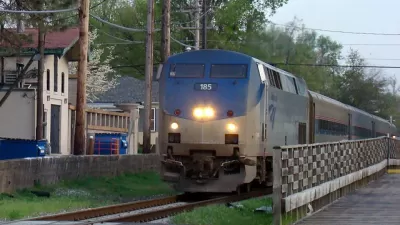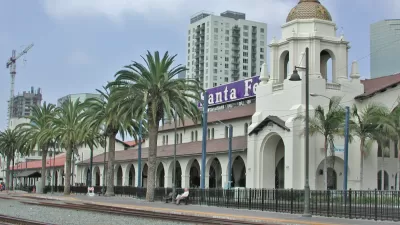High Speed Rail (HSR) is the favorite moniker to describe the new era of trains envisioned and partially down-paid by the recent stimulus. The idea, linking major regional corridors via fast trains that rival door-to-door times for air travel and put highways to shame, is a powerful elixir to the crunch of congested highways and airways that represented a failed – or to be more accurate, incomplete - twentieth century vision to satiate America's transport needs. Perhaps this vision, if implemented with undeterred gusto, can renew our perception of travel and convenience while simultaneously reinvigorating our gagged transportation system.
High Speed Rail (HSR) is the favorite moniker to describe the new era of trains envisioned and partially down-paid by the recent stimulus. The idea, linking major regional corridors via fast trains that rival door-to-door times for air travel and put highways to shame, is a powerful elixir to the crunch of congested highways and airways that represented a failed – or to be more accurate, incomplete - twentieth century vision to satiate America's transport needs. Perhaps this vision, if implemented with undeterred gusto, can renew our perception of travel and convenience while simultaneously reinvigorating our gagged transportation system.
Any Amtrak trip will reveal the HSR plan is less than nascent, and will require funding on par with the most aggressive national strategic endeavors ever pursued by our nation (Louisiana Purchase, Erie Canal, transcontinental railroad, Homestead Act, Panama Canal, New Deal, G.I. Bill, National Interstate and Defense Highways Act, Space Race, etc.). This is because our railway infrastructure is in many ways a relic of centuries past. Sadly, the massive network foundation laid by the transcontinental railroad was all but abandoned when the power of certain industries convinced our government, and us, that the way of the future was the asphalt highway or runway tarmac. Freight transport aside, we were wooed away from rail travel in the last century towards more "modern" options, such as the car and jet, leaving no regional and national mass transportation options to access the city center (let's not talk about long distance bus travel in America).
In an eighty-year quirk of modernization that is hard to parallel in other developed nations, America more or less abandoned its cities, resulting in a queer inverse land valuation that decreased as one approached the city center. Magnificent, and thoughtfully designed, train stations deteriorated, or were demolished, as the country's greatest cities fell to shambles. Dismissing rail travel resulted in the double whammy of eliminating a crucial, high capacity form of national transport, as well as dumping all those trips, transport engineering parlance for train riders, into cars or planes at an increased rate over several decades. The end result was an over-reliance on too few transport modes ill-equipped for the dynamics of an increasingly mobile American society. Only recently have we accepted the sad reality that adding lanes to stifled highways is not the solution to congestion – the solution is alternative modes of travel.
While America was experimenting on the patience of our nation's drivers and pilots, other countries were maximizing the value of their previous rail infrastructure investments with newer technology and faster service. Somehow the geopolitical truism that "America is much bigger than Europe" convinced us that HSR couldn't work here, despite the geospatial truth that the distance between New York City and Chicago is no longer than that between Paris and Rome (or Tokyo and Nagasaki for that matter). The culmination of decades of operational and hardware enhancements (most notably in Europe and Japan) is a sturdy network of high speed rail that manages comfort, convenience, and competitive cost across national boundaries, topological impediments, and comparably denser organized labor agreements.

Now the value demonstrated and progress made in other countries with HSR has been wondrously, albeit conditionally, knit back into our nation's future transportation plan as part of the new administration's efforts to reinvigorate a waning national efficiency and, more recently, a floundering economy. In another odd deviation from the ordinary, the United States stands to capitalize on the technological innovations of more advanced countries (this is commonly referred to as "leapfrogging") by building HSR infrastructure on the lessons learned elsewhere. The vision, while still entirely underfunded, is a brilliant strategy and cause for much happiness in an otherwise dismal moment in our nation's history. In an era of unexpected interstate traffic jams and perverse airport security screening, the idea of keeping my shoes on until i'm comfortably seated and dozing off in the quiet car is no less than titillating!

Planetizen Federal Action Tracker
A weekly monitor of how Trump’s orders and actions are impacting planners and planning in America.

San Francisco's School District Spent $105M To Build Affordable Housing for Teachers — And That's Just the Beginning
SFUSD joins a growing list of school districts using their land holdings to address housing affordability challenges faced by their own employees.

The Tiny, Adorable $7,000 Car Turning Japan Onto EVs
The single seat Mibot charges from a regular plug as quickly as an iPad, and is about half the price of an average EV.

Seattle's Plan for Adopting Driverless Cars
Equity, safety, accessibility and affordability are front of mind as the city prepares for robotaxis and other autonomous vehicles.

As Trump Phases Out FEMA, Is It Time to Flee the Floodplains?
With less federal funding available for disaster relief efforts, the need to relocate at-risk communities is more urgent than ever.

With Protected Lanes, 460% More People Commute by Bike
For those needing more ammo, more data proving what we already knew is here.
Urban Design for Planners 1: Software Tools
This six-course series explores essential urban design concepts using open source software and equips planners with the tools they need to participate fully in the urban design process.
Planning for Universal Design
Learn the tools for implementing Universal Design in planning regulations.
Smith Gee Studio
City of Charlotte
City of Camden Redevelopment Agency
City of Astoria
Transportation Research & Education Center (TREC) at Portland State University
US High Speed Rail Association
City of Camden Redevelopment Agency
Municipality of Princeton (NJ)





























